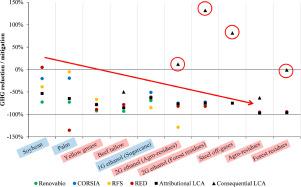Resources, Conservation and Recycling ( IF 11.2 ) Pub Date : 2020-11-12 , DOI: 10.1016/j.resconrec.2020.105260 Rafael S. Capaz , John A. Posada , Patricia Osseweijer , Joaquim E.A. Seabra

|
Although the potential of Alternative Jet Fuels (AJF) to reduce greenhouse gases (GHG) emissions has been widely reported upon in the literature, there are still discrepancies among the results. These may be due to the different GHG accounting methods, including those used by different Low-Carbon Policies (LCPs). To have a clearer understanding of the life cycle performance of AJF, the carbon footprint of ten pathways was estimated, comprising promising feedstocks – such as soybean, palm, sugarcane, sugarcane residues, forestry residues, used cooking oil, beef tallow, and steel off-gases – and ASTM-approved technologies: Hydroprocessed Fatty Acids, Alcohol-to-Jet, and Fischer-Tropsch. Six methodological approaches were used: the attributional and the consequential life cycle assessment, as well as guidelines for the four LCPs: Renovabio (Brazil), CORSIA (aviation sector), RFS (United States), and RED II (Europe). Soybean-based pathway (24 to 98.7 gCO2e/MJ) had the low to no potential for reducing GHG when compared to their fossil counterparts, mainly due to land use change. Of all food-based pathways, AJF produced from sugarcane performed the best (-10.4 to 43.7 gCO2e/MJ), especially when power surplus was credited. AJF from palm oil could present significant GHG reduction for palm expansion in degraded pasturelands. By contrast, Fischer-Tropsch of lignocellulosic residues showed the highest potential for reducing GHG (-95% to -130%). Different from food-based pathways, the potential GHG reduction of residues-based pathways converged within a narrower range (-130% to -50%), except when residual feedstocks have to be redirected from their current economic use. It could lead to GHG emissions higher than fossil fuel.
中文翻译:

巴西生产的代用喷气燃料的碳足迹:探索不同方法
尽管在文献中已广泛报道了代用喷气燃料(AJF)减少温室气体(GHG)排放的潜力,但结果之间仍然存在差异。这些可能是由于不同的温室气体核算方法所致,包括不同的低碳政策(LCP)使用的方法。为了更清楚地了解AJF的生命周期性能,我们估算了十种途径的碳足迹,其中包括有前途的原料-例如大豆,棕榈,甘蔗,甘蔗残渣,林业残渣,废食用油,牛脂和炼钢废料。气体–以及ASTM认可的技术:加氢处理脂肪酸,酒精喷射法和费托。使用了六种方法学方法:归因和相应的生命周期评估,以及四个LCP的准则:Renovabio(巴西),CORSIA(航空部门),RFS(美国)和RED II(欧洲)。与化石同行相比,基于大豆的途径(24至98.7 gCO 2e / MJ)具有降低温室气体的潜力,甚至没有降低的潜力,这主要是由于土地用途的变化。在所有以食物为基础的途径中,甘蔗生产的AJF表现最好(-10.4至43.7 gCO 2e/ MJ),尤其是在记入剩余电力时。棕榈油产生的AJF可能会显着降低温室气体,以减少退化牧场的棕榈膨胀。相比之下,木质纤维素残留物的费-托显示出减少温室气体的最大潜力(-95%至-130%)。与基于食物的途径不同,基于残留物的途径潜在的GHG减少集中在一个较小的范围内(-130%至-50%),除非必须将剩余原料从其当前的经济用途中转移出来。它可能导致温室气体排放量高于化石燃料。











































 京公网安备 11010802027423号
京公网安备 11010802027423号